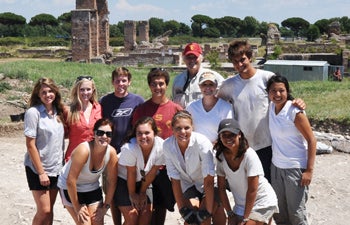Summer Excavation Class at Ostia Antica, the Port of Ancient Rome
This past summer, John Pollini, professor of classical art and archaeology in art history in USC College, led 11 students on an excavation at Ostia Antica, the important port town of ancient Rome and the third best preserved Roman town after Pompeii and Herculaneum.
Students participating in this AHIS 325 Archaeological Summer Excavation class and field school (June 21 to July 31) from USC were Olivia Aparicio, Lauren Brooks, Heather Davis, Nicholas Desantis, Mark McKinnon, Lauren McLaughlin, Thomas Parides, Alexandria Yen, and Alexandra Zigrang. Two students from Pepperdine also joined the USC class: Laurence Glasscock and Kate Brown. This course was offered in conjunction with the annual summer archaeological field school of the American Institute for Roman Culture in Rome (AIRC). Besides the USC team, 23 other students from universities and schools in the United States and Europe took part in the dig.
The first week of the class, the students learned about the monuments and topography of ancient Rome on daily walking tours of Rome. The last five weeks were devoted to excavating an important “mystery building” at Ostia that had never been excavated before. This structure was once located directly on the ancient shore of Ostia, just outside the Porta Marina (“Marine Gate”) and between a large Hadrianic bathing complex and a spectacular late Roman house, both of which had previously been excavated. The modern coastline of Ostia is now some two and a half miles to the west of the ancient city, as a result of alluvial deposits of the Tiber River during the course of 2,000 years.
The excavation itself is a collaborative project between the University of Bologna and AIRC. Italian, as well as American, archaeologists work side-by-side on this new archaeological dig. Besides digging, students had the opportunity to learn about the principles of stratification in archaeology, how to measure and draw walls, analyze and sort pottery and other finds, conserve ancient artifacts, and apply computer technology in field archaeology. On weekends, students made good use of their time by visiting sites, museums and other important of interest in Rome and other Italian cities.

Besides excavating at Ostia Antica, students had the opportunity to learn about the port town of Ostia and the spectacular finds in the site’s Archaeological Museum. Ancient Ostia was of vital commercial importance to the City of Rome since the fourth century B.C., when the Romans established a military camp at the mouth of the Tiber River, where it enters into the Mediterranean Sea. The town remained important until the Christian period (fifth to sixth centuries), when Ostia began to be abandoned due to hard economic times. It then turned into a swampy, malaria-infested area.
Although some excavations took place at Ostia in the 19th century, it was not until the Fascist period of Italy in the 1930s that most of the ancient town was finally excavated. Yet there still remain unexcavated areas of Ostia, including the large “mystery building” that we began excavating this summer. About 900 square feet of topsoil has now been removed from the site, revealing a floor plan that included an interior wall lined with three niches for statues or spouts for an elaborate water fountain known as a nymphaeum.
Also recovered were pottery fragments, transport amphoras, and many pieces of lavish colored marble wall and floor decorations, including a nearly complete rare slab of Egyptian alabaster. Among the important finds from the dig were several ancient brick stamps, whose inscriptions indicated that this structure was initially built in the period of the Emperor Hadrian (117-138).
A room at the corner of the original building yielded prolific finds and evidence for squatters occupying this space from the late third century and throughout the fourth century. Among the finds from this room were a number of bronze coins datable largely to the fourth century, marble revetment for walls, reused marble funerary block with Latin inscription, fragments of wall frescoes and part of a mosaic floor — and most exciting of all — numerous fragments of flat glass, evidence for the panes of an ancient glass window in this room.
Whether this mystery building was some grand imperial civic building or another great bathing complex remains at this point a matter of speculation. It is hoped that next summer’s excavation will answer this important question.
View an online slide show of this past summer’s excavation.
For information about AIRC’s spring program in Rome and next summer’s excavation (2011), visit www.romanculture.org.
Dr. Darius Arya, Director of AIRC, will be lecturing at USC (Thurs., Sept. 23, at 5:15 p.m. in Taper Hall 102) on this summer’s dig at Ostia. He will also discuss next year’s excavation and AIRC’s spring semester program in Rome (refreshments to follow talk).
For further information, see also Prof. Pollini, Dept. of Art History, USC: VKC 368A; pollini@usc.edu.